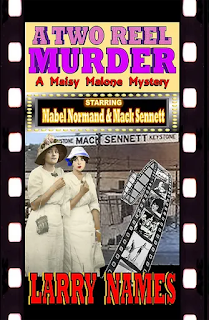You know that I have been discussing the very concept of "novel" in this blog. It is a fascinating story because, right now, we are seeing the death of a form of expression that has been among the commonest ones up to about 50 years ago. Then, it declined with the development of more visual expression forms: the TV killed the novel.
But novels are part of us; they are not dead. They are still being written and read. But they are changing in many ways and we still don't know how they will evolve. So, as part of my journey into the novel world, let me compare two novels that I happened to read during the past few months.
I cultivate the haphazard as an investigation method and, because of haphazardness, I am comparing the uncomparable: Tolstoy's "Father Sergius" (written around 1890) and Larry Names "A two Reel Murder" (ca. 2020). It is the trick I use, comparing widely different things to understand what the things have in common -- just like when I compared the story of an American waitress who found God in her job, to a science fiction novel telling the story of a Plutonian woman.
So, let's start with "Father Sergey." It is one of the last pieces by Tolstoy, more a short story than a novel. And I think it is good that it is not a full novel, because it is so dense, dark, and unforgiving, that it would not be possible to maintain the level of tension over the length of a whole novel. It is the story of someone who becomes an Orthodox Priest after that he discovers that he had been betrayed by his fiancée. Then it is all a fight against his internal demons. In a particularly tense scene, he is visited in his cell by a woman called Marovkina, who tries to seduce him. So, he cuts off one of his fingers to resist the temptation. It is a theme that was revisited in a tense Russian movie called "The Island" in 2006.
About Larry Names' "A Two Reel Murder," we have a story that sees the character of "Maisy Malone" investigating a murder that took place in Los Angeles in 1912. It is light, solar; there is not a single evil character in the whole plot, they are all good people. Even the murderer turns out to be more clumsy than evil. Ms. Malone is a little too perfect for an 18 years old girl, even able to pick a lock without problems, but she is likeable and always consistent with her role as the main character of the novel. The main strength of the novel is its background. Names reconstructed every detail of Los Angeles of the early 1910s, the time of the start of Hollywood as a major movie-making center. As you read, you learn which houses were already standing, and which ones were being built, which restaurants were operating, what was their menu, the itineraries of the lines of public transportation, and even the color of the electric cars!
You see the difference. Names' novel is pure entertainment, Tolstoy's one is pure philosophical soul-searching. It would make no sense to say that one of the novels is "better" than another. It would be like comparing a seagull with a codfish. They are both animals but living in very different environments. So, what is the point I want to make? Mainly, to show how different two entities that belong to the same category ("novels") can be. The very concept of "novel" is still evolving, and we will see what it will become.
Then, it is up to you to decide which novel of these two you would like to read, if you still read novels. What I can tell you is that I found it difficult to read Tolstoy's novel. It was so intense that it upset me. Instead, I liked Names' novel enough that I offered to the author to translate it into Italian, and it will soon appear in that language on Amazon. In the meantime, you can buy "A two reel murder" on Larry Names's site


